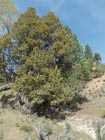
A riparian tree (note cottonwoods, Populus, in background) in the Johns Valley of Utah [C. J. Earle, 2017.09.19].
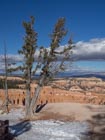
A hardy tree growing on the rim at Bryce Canyon National Park, Utah [C. J. Earle, 2015.11.20].
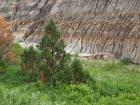
Another riparian tree, with a cluster of seedlings, at Theodore Roosevelt National Park in North Dakota [C. J. Earle, 2014.07.01].

A piñon-juniper woodland with a mix of J. scopulorum, J. osteosperma, and hybrid Pinus monophylla/P. edulis; Kolob section, Zion National Park, Utah [C. J. Earle, 2015.11.23].
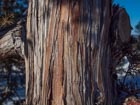
Bark on a tree about 50 cm diameter at Bryce Canyon National Park, Utah [C. J. Earle, 2013.12.06].
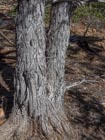
Bark on a smaller tree, also at Bryce Canyon [C. J. Earle, 2015.11.20].

Cones and foliage; also at Bryce Canyon [C. J. Earle, 2015.11.21].
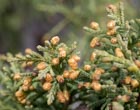
Pollen cones, very nearly ripe; also at Bryce Canyon [C. J. Earle, 2016.05.05].
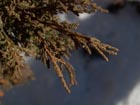
This is another juniper where the foliage turns a bronze color during winter dormancy; also at Bryce Canyon [C. J. Earle, 2013.12.06].
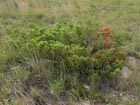
This tree clump is made up of three junipers. Mostly it is J. communis; a J. scopulorum is growing out of the communis; and creeping on the ground below is J. horizontalis. This is in the alpine zone at Buck Hill, North Dakota [C. J. Earle, 2014.07.01].
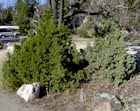
Two saplings growing in Yellowstone Natl. Park. Despite growing under almost identical conditions, one is bright green and the other extremely glaucous, illustrating how glaucousness can be almost independent of environment [C.J. Earle, 2002.08.05].

Conservation Status

Juniperus scopulorum
Sargent 1897
Common names
Rocky Mountain juniper, mountain red cedar, weeping juniper (Peattie 1950), Rocky Mountain redcedar (Adams 1993).
Taxonomic notes
Syn: Sabina scopulorum (Sargent) Rydberg (Adams 1993). Distribution contiguous with and morphology very similar to J. virginiana. J. scopulorum hybridizes with J. virginiana "in zones of contact in the Missouri River basin and with J. horizontalis (J. × fassettii Boivin; Fassett 1945). Relictual hybridization with J. virginiana is known in the Texas panhandle" (Adams 1993). Also extremely similar to Juniperus maritima, which has a disjunct distribution in the Puget Sound/Strait of Georgia area. These three species, which constitute a distinct clade on the basis of both morphological and molecular data, are probably best treated as subspecies of a single species, but have not been so described.
Other closely related species (all of which have a very similar appearance) include the Caribbean species J. barbadensis, J. bermudiana, and J. gracilior, and the Mexican species J. blancoi. These species occupy literal or biogeographic islands and likely arose through vicariance or dispersal, possibly with some level of hybridization. Hybridization has bene shown between J. scopulorum and J. maritima, and also with J. blancoi (Adams 2015, Adams et al. 2020a).
Hybridization with J. monosperma has been documented in the Guadalupe Mountains of New Mexico, which is quite surprising as these two taxa are as distant from each other as they could be within Section Sabina. The hybrids have J. monosperma chloroplasts, i.e. the pollen donor was J. monosperma, which otherwise is not known to occur within 5 km of the hybrid trees; and the nuclear DNA shows full heterzygosity at 18 loci shared by the two species, demonstrating a hybrid origin. The hybrids closely resemble J. scopulorum (Adams et al. 2020b).
Description
Dioecious evergreen trees to 14 m tall and 200 cm DBH, single-stemmed (rarely multistemmed), usually with conical to irregular crowns. Bark brown, exfoliating in thin strips, that of small branchlets (5-10 mm diam.) smooth, that of larger branchlets exfoliating in plates. Branches spreading to ascending; branchlets erect to flaccid, 3-4-sided in cross section, ca. 2/3 or less as wide as length of scalelike leaves. Leaves light to dark green, plants vary greatly in degree of glaucousness; abaxial gland elliptic, conspicuous, exudate absent, margins entire (at 20× and 40×); whip leaves 3-6 mm, not glaucous adaxially; scalelike leaves 1-3 mm, not overlapping to overlapping by not more than 1/5 their length, keeled to rounded, apex obtuse to acute, appressed or spreading. Seed cones maturing in 2 years, generally with straight peduncles, globose to 2-lobed, 6-9 mm, light blue when heavily glaucous, maturing dark blue-black beneath a glaucous coating, resinous to fibrous, with (1-)2(-3) seeds. Seeds 4-5 mm diameter. 2n = 22 (Adams 1993). See García Esteban et al. (2004) for a detailed characterization of the wood anatomy.
Distribution and Ecology
Canada, USA and Mexico; British Columbia (Vancouver Is. to the Rockies), Alberta (rare), S in Rockies through Montana, Wyoming, Colorado and New Mexico to W Texas, S-C Arizona and N Mexico; also in Washington, E Oregon, E Nevada and Utah; also on mountains E of the Rocky Mountain Front in Montana, North Dakota, South Dakota and Nebraska (Peattie 1950). Found at 0-2700 m elevation, mostly on rocky soils (Adams 1993). See also Thompson et al. (1999). Hardy to Zone 3 (cold hardiness limit between -39.9°C and -34.4°C) (Bannister and Neuner 2001).
Distribution of J. scopulorum and J. virginiana. J. scopulorum shown in red and J. virginiana in blue. Orange markers show J. virginiana var. virginiana and green markers show J. virginiana var. silicicola. Distribution data from GBIF (2023a, 2023b), presented at a resolution of 0.1 degrees latitude/longitude.
Remarkable Specimens
American Forests (1996) report the "champion" as a tree in Cache National Forest, Utah with diameter 200 cm, height 12 m, and crown spread 6 m. This tree is widely known and has been the champion for many years, but it is much less healthy than was formerly reported. The tallest tree I've heard of is 14 m tall and 64 cm dbh, near Cranbrook, BC (email from S. Walp, 2016.11.26).
The age record belongs to a log (specimen CRE 175) with crossdated inner date 29 BC and outer date AD 1859, collected in July 1993 by Henri Grissino-Mayer, James Riser, Rex Adams, and Ikuo Furukawa. The tree lived for more than 1888 years. The specimen is from El Malpais National Monument in New Mexico, an area where all native conifer species attain exceptional ages. Grissino-Mayer reports (pers. comm., January 1997) that "at El Malpais National Monument, we believe that there exist some 2000+ year old JUSCs as well."
Ethnobotany
Observations
This species is common throughout most of its range, and in much of the Rocky Mountains is the only juniper (or at least the only one in section Sabina), which makes identification relatively easy. However, I have not seen any particularly extraordinary stands.
Remarks
Citations
Adams, Robert P. 1993. Juniperus. Flora of North America Editorial Committee (eds.): Flora of North America North of Mexico, Vol. 2. Oxford University Press. This document is available online. Go to http://www.efloras.org, click on "Flora of North America," and search for "Juniperus."
Adams, Robert P. 2015. Allopatric hybridization and introgression between Juniperus maritima R. P. Adams and J. scopulorum Sarg.: Evidence from nuclear and cpDNA and leaf terpenoids. Phytologia 97: 55-66.
Adams, R. P., M. Socorro González-Elizondo and George M. Ferguson. 2020a. Allopatric hybridization and introgression between Juniperus scopulorum Sarg. and Juniperus blancoi Mart. in northern Mexico: Unidirectional gene flow. Phytologia 102: 14-26.
Adams, R. P., S. T. Johnson, R. D. Worthington, and G. M. Ferguson. 2020b. Hybridization between serrate leaf Juniperus monosperma and smooth leaf J. scopulorum in the Guadalupe Mountains, NM, USA: evidence from DNA sequencing and leaf essential oils. Phytologia 102(3):131–142.
American Forests 1996. The 1996-1997 National Register of Big Trees. Washington, DC: American Forests.
GBIF.org. 2023.01.01a. GBIF Occurrence Download, https://doi.org/10.15468/dl.tam8wd.
GBIF.org. 2023.01.01b. GBIF Occurrence Download, https://doi.org/10.15468/dl.hjasu7.
Sargent, C. S. 1897. Notes on cultivated conifers. Garden & Forest 10:420-421.
See also
Burns & Honkala 1990.
Elias 1987.
Farjon (2005) provides a detailed account, with illustrations.
Lanner 1983.
Little 1980.











